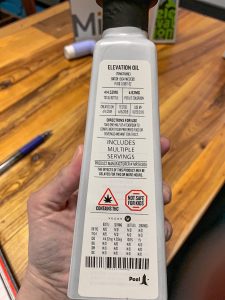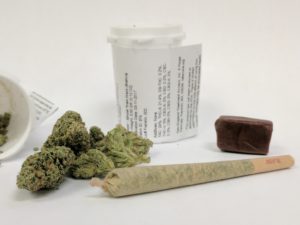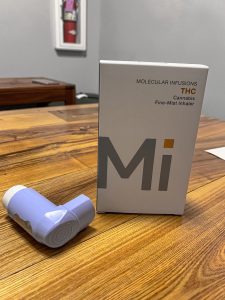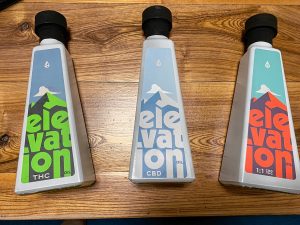On May 20, three adults collapsed in a Cape Cod restaurant after trying edibles for the first time and apparently took a relatively high dose. One woman fainted and her two companions were soon lying semi-conscious on the ground. While the unfortunate incident is not typical of most cannabis users’ experiences, it is a serious warning as to what can go wrong if consumers do not understand cannabis dosing.
In the era of cannabis legalization and brick-and-mortar retail stores, adult consumers have an overwhelming array of choices and tools to control their desired cannabis experience. Dosing is a critical component of having a positive cannabis experience and something with which every cannabis consumer should be familiar.
Active ingredients
 Cannabis is composed of a wide array of compounds called cannabinoids, which naturally occur in varying levels amongst strains of cannabis. Changing the ratio of cannabinoids, especially tetrahydrocannabinol (THC) and cannabidiol (CBD), can alter the user’s cannabis experience. A 1:1 ratio of CBD: THC is often recommended for neuropathy and pain, whereas a 10:1 ratio may be better suited for anxiety. Increasing CBD in dosing may provide therapeutic effects while allowing the user to be more clear-headed and functional. Cannabis medical dispensaries, cannabis medical professionals, and research clearinghouses, such as Project CBD, are all resources to learn more about how cannabinoid ratios impact medical conditions.
Cannabis is composed of a wide array of compounds called cannabinoids, which naturally occur in varying levels amongst strains of cannabis. Changing the ratio of cannabinoids, especially tetrahydrocannabinol (THC) and cannabidiol (CBD), can alter the user’s cannabis experience. A 1:1 ratio of CBD: THC is often recommended for neuropathy and pain, whereas a 10:1 ratio may be better suited for anxiety. Increasing CBD in dosing may provide therapeutic effects while allowing the user to be more clear-headed and functional. Cannabis medical dispensaries, cannabis medical professionals, and research clearinghouses, such as Project CBD, are all resources to learn more about how cannabinoid ratios impact medical conditions.
When consuming a cannabis product purchased at a retail store, consumers should carefully read the state-required product label and independent lab testing results — prior to ingesting the product — to know the total cannabinoid content, cannabinoid breakdown (percentage of THC, CBD, etc.), and portion size. (Don’t be that person who eats the whole chocolate bar only to learn it was twice as strong as you thought it was!)
How much and how often
The dosing size and frequency are important considerations. New cannabis consumers should start “low and slow.” For some cannabis users, once per day or as needed is sufficient. For others, the consumer or patient may need to consume multiple times throughout the day. Amherst-based cannabis consultant Julia Agron suggests starting with a very small dose, anywhere from 1 to 2.5 miligrams of THC, and working up from there. A good starting dose for CBD, Agron recommends, is 25 to 50 miligrams; consumers often report fewer aches and pains, fewer headaches and migraines, and better digestion at this dose.
Discovering your ideal cannabis dose can be tricky because it varies for each person. For one user, one to two milligrams of cannabinoids may provide therapeutic effects, while another may require hundreds or even thousands of milligrams to achieve the desired effect. Experts can provide you with the tools and information to get started, but ultimately a cannabis user will need to experiment and take notice of the effects.

Medical marijuana — buds, a pre-rolled joint, and a caramel-cocoa “nugget” — from NETA in Northampton.
How much plant material remains in the cannabis product also impacts the dosing and user experience. Agron likens the synergistic interactions of cannabinoids to a symphony, where consumers may get the most dynamic and impactful experience by using whole plant or full spectrum cannabis and hemp products. Today, you can get products made from a variety of cannabis extractions: whole plant extract (fullest extraction, with plant materials such as fats and fibers), full spectrum (broad array of naturally-occurring cannabinoids), distillate (refined concentration of desired cannabinoids), and isolate (isolated cannabinoids, e.g. only CBD or THC).
“Studies have shown that full spectrum is more effective than isolate, and more effective at lower doses,” says Agron. “With full spectrum, increased doses can have an increased efficacy. However, isolate stops working in efficacy at approximately 25 milligrams.”
Many cannabis users are also experimenting with microdosing, or consuming very low levels of cannabis throughout the day, in order to reap the therapeutic benefits while maintaining a clear head and avoiding psychoactivity. Microdosing has been a game changer for several demographics of cannabis consumers, from “microdosing moms” to medical patients who hold down day jobs. Agron’s go-to microdosing product recommendation are small gummies, which may be eaten as an edible or put under the tongue and used like a lozenge.
Dosing products
 Local medical cannabis dispensaries and adult-use retail stores sell a wide array of cannabis products that provide consumers easy ways to dose. Tinctures, edibles, and transdermal patches all take the guess work out of dosing.
Local medical cannabis dispensaries and adult-use retail stores sell a wide array of cannabis products that provide consumers easy ways to dose. Tinctures, edibles, and transdermal patches all take the guess work out of dosing.
State regulations require that adult-use cannabis edibles are portioned or scored into five-milligram individual sizes, while medical cannabis products may allow for larger portions.
New England Treatment Access (NETA) Trainer Jacob Moriarty explains a few of the lesser-known products.
Elevation Oil is a versatile, ready-to-use, cannabis-infused grapeseed oil that can be used in a variety of ways: as an additive to a drink, cooked or baked into any recipe, as a topical, and as a tincture. A half teaspoon of Elevation Oil yields approximately five milligrams of cannabis oil, and is available in THC, CBD, and 1:1 (CBD:THC) varieties.
Molecular Infusions Fine-Mist Inhaler is a cannabis inhaler — much like an asthma inhaler — that dispenses approximately 2.4 milligrams of THC with each click. The inhaler currently comes in THC, with plans to manufacture CBD and 1:1 varieties as well. Moriarty explains that it may take up to 10 minutes to feel the effects and patients who experience throat irritation as a side effect of smoking or vaporizing may have better luck with the fine mist inhaler, which is gentler on the throat, odorless, and leaves no cotton mouth.
 D-Line Drops are a water-soluble beverage additive to be consumed in flavored beverages like smoothies, juice, soda, and coffee. Moriarty likes to add his D-Line Drops in Earl Gray tea. Each D-Line Drop is approximately one milligram and is available in THC, CBD, and 1:1 varieties.
D-Line Drops are a water-soluble beverage additive to be consumed in flavored beverages like smoothies, juice, soda, and coffee. Moriarty likes to add his D-Line Drops in Earl Gray tea. Each D-Line Drop is approximately one milligram and is available in THC, CBD, and 1:1 varieties.
Cannabis consumers can also create their own discretely-dosed cannabis products at home. Adults may legally grow their own cannabis inside the home or outside on private land. Consumers may also make their own edibles, which may be cheaper and provides the flexibility to accommodate special diets. The home baker may find many free recipes on the website Wake + Bake (wakeandbake.co). I personally like Wake+Bake’s handy online dosage calculator, which will allows the user to input flower quantity and potency, calculating the cannabis dose per recipe and serving.
No matter what your cannabis preferences are, set yourself up for success. Stay hydrated and ensure your environment supports your goals for cannabis usage. Be sure to read all the product labels and go low and slow. With the proper dosing information in hand, and a little experience under your belt, you’ll be able to have the desired experience and become a savvy, informed cannabis user.
Karima Rizk is an Easthampton-based cannabis advocate, entrepreneur, and professional. She can be reach at krizkconsulting@gmail.com.


